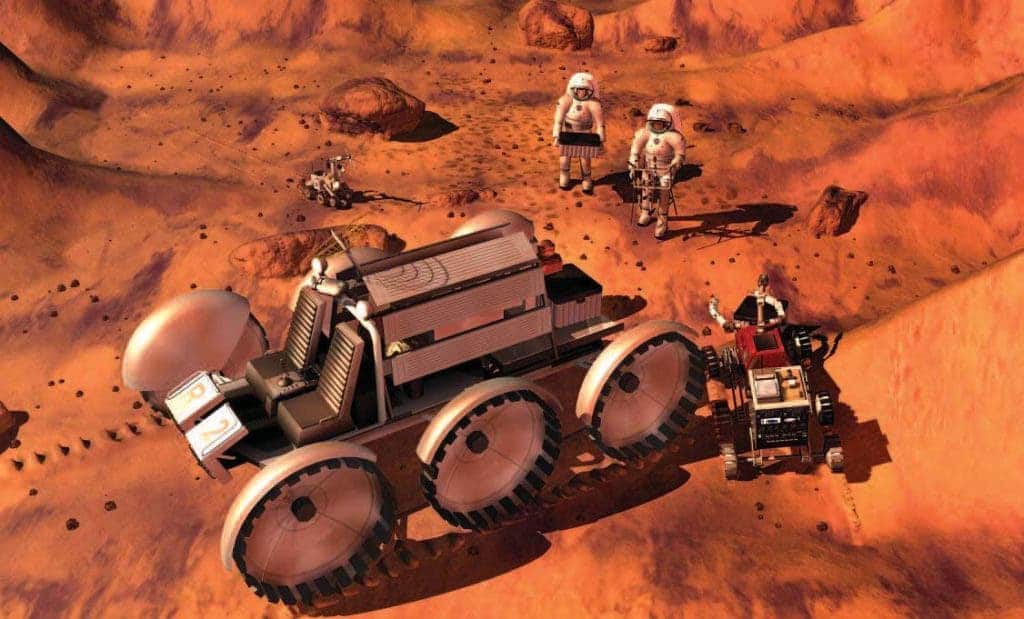
At some point, humans might settle Mars. But according to an evolutionary biologist, babies born on the Red Planet will look, function, and behave dramatically different from Earthlings—and all within a few generations.
Tech entrepreneurs and technologists like Elon Musk or Jeff Bezos love to talk about our species’ future as a multi-planetary species. And to be fair, they’re actually making important contributions to turn this vision into a reality. But while there’s a lot of focus on the technology that might take us to places such as Mars, not nearly as much thought seems to be given to what happens once we actually get there.
Mars is the most Earth-like planet in the solar system, so it makes sense to make it the first target for an off-world colony. Similar to Earth, Mars has a pair of polar ice caps. Its north pole is made up of a sheet of ice water that is 1.8 miles thick. The sheet at the opposite pole is even thicker and mostly made of carbon dioxide ice.
There are also important differences between the two worlds. Mars is smaller than Earth, with a diameter of approximately 4,200 miles, and the air is comprised mainly of carbon dioxide — it makes up 95 % of its very thin atmosphere. The air pressure on Mars is less than one percent of sea level pressure here. Temperatures on Mars regularly reach a chilling -195 degrees Fahrenheit (-125 degrees Celsius).
It wasn’t always like this. Mars used to support volcanic activity (Mars is home to the largest volcanoes on any planet in our solar system) during a time when water in its liquid phase is believed to have been quite plentiful. In addition, Mars had a thick atmosphere and a magnetic field which would have been capable of shielding the cold surface from dangerous levels of radiation — but not anymore.
Homo martianus
Any human colonists settling Mars would have to be confined to a relatively small habitat where they’d be subject to significantly higher radiation and more difficult living conditions than on Earth. In time, natural selection would amplify certain traits in the Martian population that would considerably differentiate humans born on the Red Planet from Earthlings. And according to Scott Solomon, a Rice University professor of evolutionary biology, this could happen within just a couple of generations.
“Evolution is faster or slower depending on how much of an advantage there is to having a certain mutation,” Solomon told Inverse. “If a mutation pops up for people living on Mars, and it gives them a 50-percent survival advantage, that’s a huge advantage, right? And that means that those individuals are going to be passing those genes on at a much higher rate than they otherwise would have.”
Among other things, Solomon expects Martians will develop the following traits:
- Denser and more brittle bones due to Mars’ weaker gravity, which is just a third that of Earth’s.
- Near-sightedness since people won’t have to see as far as they would on Earth. Solomon cites studies of cavefish living in deep trenches that have gone blind in pitch-black darkness and of children who spent more time indoors, making them far more likely to become near-sighted.
- Altered skin tone in response to high levels of radiation. On Earth, human skin contains a pigment called melanin that protects us from ultraviolet rays. People with more melanin in their skin have a darker skin tone. To fight off radiation, Martians might evolve an entirely new type of pigment so it might not be that far-fetched to imagine Martians with a skin tone that doesn’t exist yet.
- Enhanced oxygen intake. Martian settlers will have to learn to use oxygen more efficiently and will perhaps adapt traits similar to humans living on the Tibetan plateau where oxygen is 40% lower than at sea level. To cope, Tibetans have denser capillaries that are better at moving blood and altered metabolism that limits the amount of body fat burned while maximizing glucose consumption.
- Poor immune system — or none at all. Solomon thinks that the Martian sterile environment might make an immune system obsolete. With no immune system, Martians would have to be off limits from germ-carrying Earthlings, which means that the two populations would have to stop mingling. This also means that at some point there would be no more traveling between the two worlds — and there would certainly be no more sex between them. Lacking any gene flow, in time the two populations would diverge so much that speciation would become inevitable — Homo martianus?
These changes could happen very quickly, spurred by radiation which enhances genetic mutations, but also by artificial means through gene editing tools like CRISPR/Cas9.
According to Solomon, the ideal human colony should number around 100,000 people from all corners of the globe, especially those from Africa who are the most genetically diverse. This is in order to ensure a healthy genetic diversity.
Some hope that we might one day terraform Mars to make it a second Earth. But even if such an ambitious undertaking were possible, it would still take centuries to complete — ample breeding time for Martian settlers to comfortably drift away from humanity.
You can learn more about how humans on Mars might change over the generations from Solomon’s 2018 TEDx speech.
This article originally appeared in 2019 and was republished by our editors with some more timely updates.




